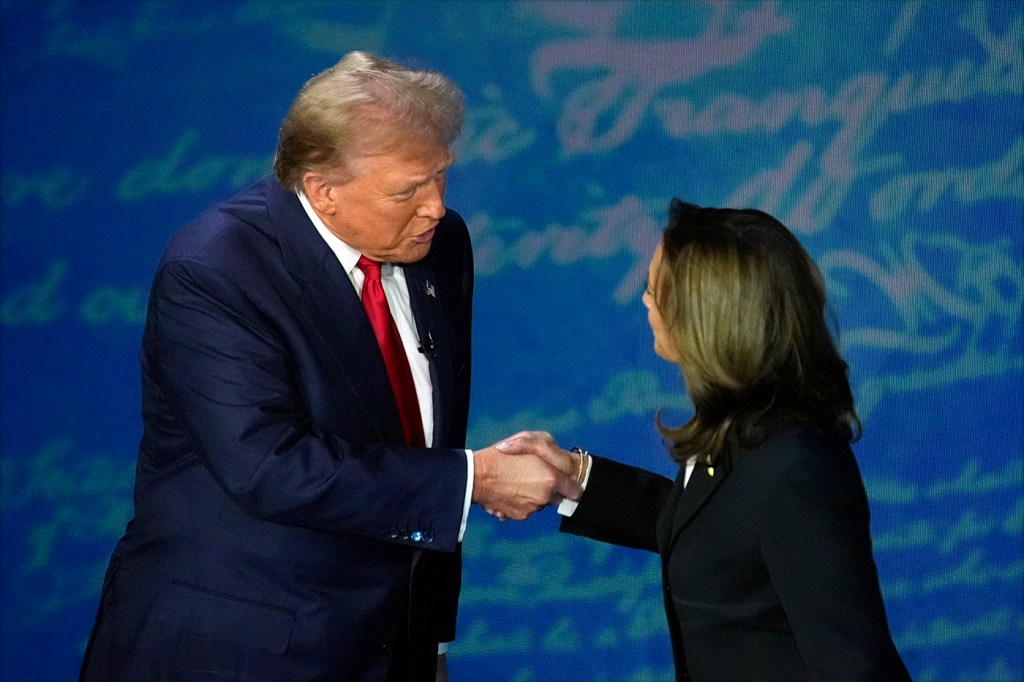Trump-Harris debate takeaways: Experts dissect body language, policy banter and other moments
Vice President Kamala Harris and former President Donald Trump spent just over 90 minutes face-to-face on a Philadelphia debate stage Tuesday evening — an occasion that made for some memorable moments.

Vice President Kamala Harris and former President Donald Trump spent just over 90 minutes face-to-face on a Philadelphia debate stage Tuesday evening — an occasion that made for some memorable (and less memorable) moments.
Here are some of the key takeaways.
Policies
Nick Beauchamp, associate professor of political science at Northeastern University, says Tuesday’s debate offered little in the way of a substantive policy discussion.
Harris didn’t unveil any sweeping new policies to help fill in her otherwise barren platform, which reads as though it’s ripped straight from President Joe Biden’s campaign website. She opted instead to emphasize what he called “small-bore” policies: money for homebuyers, new parents and a $50,000 deduction for entrepreneurs.
“Her new policy page is virtually empty of anything ambitious, with the exception of the Child Tax Credit, which would have a substantial effect but is currently being framed as a tax cut rather than around the millions of children it would lift out of poverty,” Beauchamp says.
“The rest of it is just ‘continue’ and ‘fight for,’ which is unlikely to have much effect on the tiny slice of undecided viewers,” he says. “This is perhaps understandable given that gridlock means that, unlike most democracies, ours is systemically unable to pass popular policies — and people know it. But even unrealistic policies of the kind promulgated in 2020 are largely absent.”

Abortion and immigration arguably constituted the bulk of the middle part of the debate. On abortion, Trump seemed vexed, dodging somewhat the question of whether he would veto a national abortion ban.
Harris emphasized her commitment to reproductive rights, noting she would reinstate protections lost when Roe v. Wade was overturned; however, she dodged the question of whether she would allow abortions in the seventh, eighth or ninth months of a pregnancy.
Beauchamp says Trump appeared to use the topic of immigration as a crutch when he ran out of talking points.
By the end of the night, the candidates had little left in the tank for a discussion of the Russia-Ukraine and the Israel-Hamas wars.
“There are real disagreements here, but by the time the debate got to them, the audience was unlikely to have been paying much attention,” Beauchamp says. “Both are weak on both topics because both topics are difficult to resolve, so both were happy to change the topic.”
A ‘gendered’ debate
Much attention was paid to how the two candidates interacted with each other on the stage — from the handshake (at Harris’ insistence), to the way they addressed each other, and other telling mannerisms.
Even the candidates’ laughter told a story.
“Notice [Harris] laughed only a couple times and not for long. It was hard not to laugh after the dog-eating debate,” says Martha Johnson, an associate professor of government at Northeastern. “She also held back her smile. One of her primary goals seems to be to convey how seriously she takes the problems facing American voters and to emphasize the importance of American democracy and the role of the presidency.”
“What is perhaps most striking to me is just how little respect Trump showed Harris,” Johnson says. “He rarely looked at her. He only directly addressed her to ask facetiously whether she remembered saying ‘I’m talking now.’ Later, he said ‘quiet now.’”
Johnson said Trump “denied her ownership of any policies or policy ideas,” a tactic apparent in his referring to Biden as “Harris’ boss” on several occasions.
“This approach contrasts with his engagement with Hillary Clinton,” Johnson says. “It is possible that his lack of engagement is partly because his team prepped him not to personally attack Harris, but it seems more likely that it stems from his lack of respect for Harris, which can’t be understood without attention to his gender and racial attitudes.”
Audience and voter reception
Depending on where you look, the consensus among one stripe of media is that Harris (“the political professional”) came out on top in what looked to be a pretty lopsided debate. Beauchamp says it will be interesting to see whether the focus groups and instant polls agree with the media’s “strong views” about the outcome.
“Many in the media are giddy with the sport of all this, and eager for something as gratifying as the previous debate, which ratified their importance in this whole process,” Beauchamp says. “Can they be satisfied with a normal debate — Trump being Trump, Harris attempting to act strong and pivoting to small-bore policies — or will the desire for blood cause them to magnify small gaffes in an effort to relive the previous drama?”
As the race tightens, the question of what it might take to lure swing voters becomes all the more pertinent to both campaigns.
After this week’s debate, will voters have now “seen enough of Harris” to form an opinion of her?
“This gets back to ‘presidential’ and gender-based perceptions more than policies, if only due to the near-absence of substantial policy proposals,” Beauchamp says.






